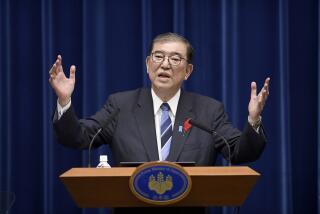Koizumi Spirals Down
- Share via
Japanese Prime Minister Junichiro Koizumi stumbled badly when he suddenly dumped his close ally, Makiko Tanaka, from the foreign minister’s job in late January.
Within a week, Koizumi’s rating dropped from the 70% range to an anemic 40%-plus in some polls. A storm of press criticism attacked his tactics in the firing.
On every front, the “Koizumi spiral,” as an opposition party characterized it, continues to go down. Once-tolerant critics grow increasingly impatient, and there are even predictions that his Cabinet will fall. Unless he returns to his original reform policy, his days in office may be numbered.
Tanaka, the blunt-spoken daughter of a former prime minister and the country’s most popular vote-getter, had not been a great success at a job that calls for at least a modicum of finesse. But she had tried to take a strong hand in curbing the power of an arrogant but inefficient bureaucracy mired in scandals. In so doing, Tanaka drew considerable public support. But she ran afoul of ministry bureaucrats and their behind-the-scenes boss, veteran parliament member Muneo Suzuki.
To understand what happened and why, one needs a little indoctrination into the murky workings of Japan’s one-party government. That would help explain the 10-year stagnation of what was once the world’s most burgeoning economy.
During the half-century of Liberal Democratic Party rule--broken only for a year in 1993 by an insurgent minority Cabinet--the party’s hierarchy has made common cause with leaders of the once-independent bureaucracy.
Members of the parliament are divided into groups of zokugiin, a term that is best translated as “special interest representatives.” Their constituencies include construction, banking, farming, government-owned corporations, small business, even foreign relations.
These representatives work with businessmen and bureaucrats to safeguard each of their special areas. There are few outside lobbyists in Japan because the parliament members themselves are lobbyists par excellence.
Koizumi won the prime ministership on a reform platform after his seven predecessors in 10 years had done nothing to correct the stalled economy.
His program was simple but sweeping: Cut wasteful public works spending, deregulate the web of outmoded government “guidance,” stop propping up losing industries and debt-drowned banks, clip the wings of special interest members of parliament and protected bureaucrats.
The public responded to his message by reelecting his party with a strong majority. Once in power, however, the party’s elected lobbyists went back to their old ways, each gang defending its own turf.
One by one, Koizumi initiatives were blocked or watered down by special interest votes of party factions, a practice that Tanaka had loudly denounced.
Koizumi’s reason for firing Tanaka was that her latest argument with ministry bureaucrats and Suzuki was holding up passage of the budget bill. He made no attempt to evaluate who was right or wrong. His lack of clear decision-making, coming after so many failed efforts at reform, was enough to exasperate a good portion of the public.
There is no mystery about the causes of Japan’s 10-year recession. In a new world of globalized finance, information technology and international economic competition, the old mix of government guidance, built-in protectionism and indiscriminate bank financing had become hopelessly outdated and counterproductive.
Economists and big business leaders have agreed that far-reaching structural reform is needed to reinvent a healthy free-enterprise economy in Japan.
But the party’s parliament lobbyists refuse to accept the temporary bankruptcies and job losses that come with any major long-term reform.
Stopgap government pump-priming--the Liberal Democrats’ only tactic--has repeatedly failed. Understandably disillusioned, the public lost confidence and stopped consuming.
There are businessmen and economists aplenty who know what should be done. So does the prime minister. The real problem is political. Until Koizumi starts controlling the party bosses (or goes to the public with a new multi-party lineup), the economic reforms that Japan needs will remain an empty promise.
Japanese voters are tumbling to this fact, which explains the angry phone calls and Koizumi’s slipping poll numbers following Tanaka’s dismissal.
More to Read
Sign up for Essential California
The most important California stories and recommendations in your inbox every morning.
You may occasionally receive promotional content from the Los Angeles Times.










